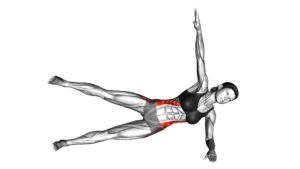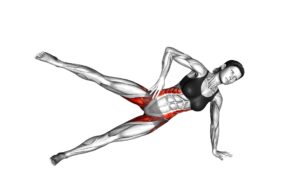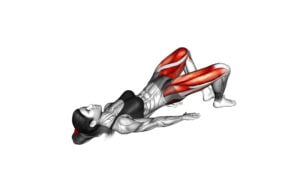Bridge Hip Abduction – Video Exercise Guide & Tips

Are you looking to strengthen your hip muscles and improve your overall lower body stability? Look no further!
Watch This Exercise Video
In this video exercise guide, we will walk you through the proper form and technique for bridge hip abduction.
With just a few minutes a day, you can reap the benefits of this effective exercise.
So grab your mat and let's get started on your journey to stronger hips!
Key Takeaways
- Bridge hip abduction targets muscles in the hips, glutes, and core for improved strength and stability.
- Incorporating bridge hip abduction into a workout routine can enhance posture, alignment, and athletic performance.
- Using proper form and technique, along with gradually increasing intensity, can maximize the effectiveness of bridge hip abduction.
- Adding variations and progressions, such as single-leg bridge and resisted bridge, can further challenge and engage the hip abductor muscles.
Benefits of Bridge Hip Abduction
You will experience several benefits from regularly performing bridge hip abduction exercises. These exercises specifically target the muscles in your hips, glutes, and core, helping to strengthen and tone these areas.
One of the main benefits of bridge hip abduction exercises is the improvement in hip stability. By strengthening the muscles around the hip joint, you can reduce the risk of injuries and improve your overall balance and coordination.
Additionally, these exercises can help to improve your posture by engaging the muscles in your lower back and core, leading to a more upright and aligned spine.
Another benefit is the activation and strengthening of the glute muscles, which can help to enhance your athletic performance in activities such as running, jumping, and squatting.
Lastly, bridge hip abduction exercises can also be beneficial for individuals who experience lower back pain, as they can help to alleviate tension and improve flexibility in the area.
Now that you understand the benefits of bridge hip abduction exercises, let's move on to the equipment needed for performing these exercises.
Equipment Needed for Bridge Hip Abduction
To perform bridge hip abduction exercises, you'll need a resistance band and a stable surface such as a mat or exercise bench. Resistance bands are essential for adding resistance to the exercise and increasing the intensity of the movement. They come in various levels of resistance, allowing you to choose the one that suits your fitness level and goals. The bands are lightweight and portable, making them ideal for home workouts or when you're on the go.
In addition to the resistance band, you'll also need a stable surface like a mat or exercise bench. This provides support and stability during the exercise, ensuring that you can perform the movement safely and effectively. It's important to choose a surface that's comfortable and sturdy, allowing you to maintain proper form throughout the exercise.
By incorporating resistance bands and utilizing bodyweight exercises, you can effectively target and strengthen your hip abductor muscles. These muscles play a crucial role in stabilizing the pelvis and legs, improving overall lower body strength and stability.
Now that you know the equipment needed for bridge hip abduction exercises, let's move on to the next section where we'll discuss the proper form and technique for this exercise.
Proper Form and Technique for Bridge Hip Abduction
To perform the bridge hip abduction exercise with proper form and technique, it's essential to focus on optimal hip alignment, engage your glute muscles, and avoid common form mistakes.
Start by lying on your back with your knees bent and feet flat on the ground. As you lift your hips off the floor, make sure to keep your hips in line with your knees and shoulders, squeeze your glutes at the top of the movement, and avoid overarching or tilting your pelvis.
Optimal Hip Alignment
Achieving optimal hip alignment is crucial for performing the bridge hip abduction exercise with proper form and technique. Proper hip alignment ensures that you target the correct muscles and minimize the risk of injury.
When your hips are properly aligned, you engage the gluteus medius and minimus muscles effectively, which are responsible for hip stability and abduction. This helps improve your overall hip strength and stability, reducing the risk of common hip-related issues such as hip bursitis and iliotibial band syndrome.
To enhance hip alignment, it's important to incorporate hip stability exercises into your routine. These exercises focus on strengthening the muscles around the hips, improving their ability to stabilize the joint and maintain proper alignment.
Engaging Glute Muscles
You can engage your glute muscles properly by focusing on form and technique during the bridge hip abduction exercise. Glute activation is crucial for hip strengthening and overall lower body stability.
To engage your glutes effectively, start by lying on your back with your knees bent and feet flat on the ground. Lift your hips off the floor while keeping your core engaged and your glutes squeezed.
As you raise one leg out to the side, make sure to maintain a straight line from your shoulders to your knees. This will ensure that your glutes are properly activated throughout the movement.
Common Form Mistakes
Avoid these common form mistakes to ensure proper form and technique for the bridge hip abduction exercise.
Improper alignment is one of the most prevalent mistakes people make during this exercise. It's important to maintain a straight line from your shoulders to your knees, avoiding any sagging or arching of the lower back. Keep your core engaged and your pelvis in a neutral position to prevent any undue stress on your spine.
Another common mistake is a lack of hip activation. Make sure to actively squeeze your glutes as you lift your hips off the ground, focusing on using the muscles in your hips rather than relying solely on your lower back.
Common Mistakes to Avoid During Bridge Hip Abduction
To perform the Bridge Hip Abduction exercise correctly, it's important to be mindful of certain errors. Here are some common mistakes to avoid during Bridge Hip Abduction:
- Incorrect positioning: One common mistake isn't aligning your body properly. Make sure your shoulders, hips, and knees are in a straight line to maintain proper form throughout the exercise.
- Lifting too high: Another mistake is lifting your hips too high during the abduction movement. This can put unnecessary strain on your lower back and may reduce the effectiveness of the exercise. Focus on lifting your hips to a comfortable height without compromising your form.
It is crucial to be aware of these common mistakes to ensure that you're getting the most out of your Bridge Hip Abduction exercise. By avoiding these errors, you can minimize the risk of injury and maximize the benefits of the exercise.
Now, let's move on to discussing the variations and progressions of Bridge Hip Abduction.
Variations and Progressions of Bridge Hip Abduction
Now let's explore different ways to challenge and advance your Bridge Hip Abduction exercise. By incorporating variations and progressions into your routine, you can continue to strengthen and target your hip abductor muscles effectively.
One variation you can try is the single-leg bridge hip abduction. Start by lying on your back with your knees bent and feet flat on the ground. Lift one leg off the ground and extend it straight in front of you. Engage your glutes and core as you lift your hips off the ground, maintaining a straight line from your shoulders to your extended leg. Lower your hips back down and repeat on the other side.
Another advanced bridge hip abduction exercise is the resisted bridge. You can use a resistance band or a weighted plate placed on your hips to increase the challenge. The resistance will engage your muscles even more, helping to build strength and stability.
Remember to always focus on proper form and technique during these variations. Keep your core engaged, hips level, and avoid arching your lower back. Start with lower resistance or fewer repetitions and gradually increase as you become more comfortable and stronger.
Incorporating these bridge hip abduction variations into your workout routine will help you continue to progress and challenge your muscles, leading to improved strength and stability in your hip abductors.
Tips for Incorporating Bridge Hip Abduction Into Your Workout Routine
To effectively incorporate Bridge Hip Abduction into your workout routine, consider these tips for maximizing the effectiveness of the exercise:
- Use resistance bands: Adding resistance bands to your Bridge Hip Abduction can help increase the intensity of the exercise. Simply place the band around your thighs, just above your knees, and perform the exercise as usual. The resistance from the band will challenge your muscles even more, leading to greater strength gains.
- Modify intensity levels: Depending on your fitness level, you may need to modify the intensity of the exercise. If you're a beginner, start by performing the exercise without any extra weight or resistance bands. As you become more comfortable and stronger, gradually increase the difficulty by incorporating resistance bands or holding a weight on your hips. Remember to listen to your body and progress at a pace that feels challenging but manageable.
- Focus on form: Proper form is crucial for getting the most out of the Bridge Hip Abduction exercise. Make sure your feet are hip-width apart, and your knees are aligned with your toes. Engage your glutes and core to lift your hips off the ground, keeping your back straight. Avoid overarching or sinking your lower back. Squeeze your glutes at the top of the movement and lower down with control.
Frequently Asked Questions
How Many Sets and Repetitions Should I Do for Bridge Hip Abduction?
To determine the number of sets and repetitions for bridge hip abduction, it's important to consider different variations and the benefits it offers to athletes.
Bridge hip abduction targets the gluteus medius and can enhance hip stability and strength.
It's recommended to start with 2-3 sets of 10-15 repetitions, gradually increasing as you progress.
However, it's always best to consult with a fitness professional to tailor the workout to your specific needs and goals.
Can Bridge Hip Abduction Help With Improving Balance?
Bridge hip abduction exercises can indeed help improve your balance and stability. By targeting the muscles in your hips and glutes, these exercises strengthen the muscles responsible for maintaining balance.
The benefits of hip abduction exercises extend beyond balance improvement, as they also help with overall hip and core strength. Incorporating bridge hip abduction exercises into your fitness routine can be a valuable addition for enhancing stability in your everyday movements.
Is Bridge Hip Abduction Suitable for Beginners or Is It More Advanced?
Bridge hip abduction is a great exercise for improving strength and stability in your hips and glutes. It targets the muscles responsible for abduction and helps to improve balance.
Beginners can start with modifications like using a resistance band or performing the exercise with bent knees. As you gain strength and confidence, you can progress to more advanced variations.
Be mindful of common mistakes like lifting your hips too high or not engaging your core.
Can Bridge Hip Abduction Help With Reducing Lower Back Pain?
Bridge hip abduction is a great exercise for reducing lower back pain. By engaging your glutes and strengthening your hips, bridge hip abduction helps to stabilize and support your lower back. This exercise also improves overall strength and flexibility, making it beneficial for everyone, including beginners.
To perform bridge hip abduction correctly, lie on your back with knees bent, feet flat on the floor. Lift your hips off the ground, then slowly abduct one leg out to the side, keeping your hips level. Repeat on the other side.
Is It Necessary to Use Resistance Bands or Weights for Bridge Hip Abduction, or Can It Be Done Without Any Equipment?
Using resistance bands or weights for bridge hip abduction can provide added benefits to your workout. However, it isn't necessary to use any equipment for this exercise. Bridge hip abduction can be done without any equipment, making it a convenient option for those who don't have access to resistance bands or weights.
There are also variations of bridge hip abduction exercises that you can try to target different muscle groups and add variety to your routine.
Conclusion
Incorporating bridge hip abduction into your workout routine can provide numerous benefits, such as strengthening the hip muscles and improving stability. By following the proper form and technique, you can maximize the effectiveness of this exercise.
Avoiding common mistakes and gradually progressing to more challenging variations can help you achieve better results. Remember to use the appropriate equipment and consult with a fitness professional for personalized guidance.
Start incorporating bridge hip abduction into your workouts to enhance your overall fitness level.

Author
Years ago, the spark of my life’s passion ignited in my mind the moment I stepped into the local gym for the first time. The inaugural bead of perspiration, the initial endeavor, the very first surge of endorphins, and a sense of pride that washed over me post-workout marked the beginning of my deep-seated interest in strength sports, fitness, and sports nutrition. This very curiosity blossomed rapidly into a profound fascination, propelling me to earn a Master’s degree in Physical Education from the Academy of Physical Education in Krakow, followed by a Sports Manager diploma from the Jagiellonian University. My journey of growth led me to gain more specialized qualifications, such as being a certified personal trainer with a focus on sports dietetics, a lifeguard, and an instructor for wellness and corrective gymnastics. Theoretical knowledge paired seamlessly with practical experience, reinforcing my belief that the transformation of individuals under my guidance was also a reflection of my personal growth. This belief holds true even today. Each day, I strive to push the boundaries and explore new realms. These realms gently elevate me to greater heights. The unique combination of passion for my field and the continuous quest for growth fuels my drive to break new ground.







